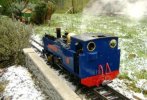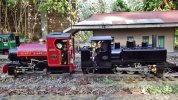I run on 45 mm gauged LGB type track, both UK/Colonial 16 mm scale and US outline (both rodded and geared)1:20.3 scale locos. All my locos are butane gas fired , poker type burner. I have both Roundhouse and Accucraft makes. Some gas fired locos use a "ceramic" burner, usually larger ones. Mixed reviews of that type.
First - Join a club or association that runs live steam and try to get your hands on one to run before you buy. Buy what floats your boat, but be aware of any caveats that may apply to any chosen loco and its design. Start simple and small, if you can. Avoid "slip ecentric" type drives, low cost but a pita if you are going RC. Buy from a reputable source who will provide advice and back up. Live steamer as you will be aware is a big outlay.
Roundhouse are the most reliable and have the best back up and long term spares support. Accucraft have, through their various divisions (US, D, UK) the widest variety of subject matter and scales for running on 45 mm gauged track. Theirs are mostly good well detailed accurate scale models, however, they can have issues due to manufacturing QC issues (sortable) and spares support. Roundhouse do their own RC fitting, try to get a later one fitted with the compact Fosworks TX options or get it retro fitted. Accucraft RC installs tend to be by dealers and of variable quality and TX type. If buying 2nd hand check the receiver battery condition.
Roundhouse/Accucraft 16 mm scale locos, i.e. mostly British/Colonial subject matter, are gauge adjustable 32/45 mm. There are some exceptions, usually "outside frame" prototype designs, that are built fixed gauge from the factory. Accucraft's, and others, 1:20.3 scale locos as they are usually models of 3ft gauged prototypes are fixed at 45 gauge. Again there is are odd exceptions, so check before you buy.
While having a raised "steam up" area is desirable it is not essential. 30" above ground should be sufficient if you do. Use wood sleepered track or a wood board with grooves gauged for your loco, you can melt plastic sleepers under a stationary loco left unattended with the burner turned up full, don't ask me how I know. If you have a smaller loco, say a non tender 6 coupled or small geared, then steaming on a separate raised area is manageable. Once you are lit up and the safety valve is lifting pick up firmly by the buffer beams an place on the track. Roundhouse provide handy gloves for that. Been there done that.
Controlling a loco yourself is the best fun, especially if you have gradients on a line. If you just want to sit back and watch the train go around get a geared loco like a Shay or Climax type. Geared locos just chug around, there is a lot of inertia in their mechanisms to stop them running away, unlike a conventional rodded loco.
Yes, depending how you feel, it can seem a bit of a faff prepping and getting it all up to steam but once you are running, especially on a cold or humid day, the sound of that chuff and the plume of steam coming from the loco's chimney can't be beat. Running times between refils are variable dependng on your skills and loco design. Usually threy are designed to run out of gas (before water) after around 20 - 30 mins. Some locos are designed to be "fill while run" from a water bottle, extending "continuous" run time. Please excuse my usual magnum opus, hope it provides encouragement. Max
P.S. Other major makes like Regner or Bowande I have no experience of but I they offer some interesting options and are long established makes. There are some very fine "artisan" made products out there but they tend to be at the top end of the market, with some being coal fired (Accucraft have offered coal fired too). Whole different ball game when you get into coal fired at these smaller scales. Aspire to it but try not to start there, unless you are very committed and with a very healthy bank balance.
Steaming in the winter snow



